Long-Term Conservation for the Safeguard of Abies nebrodensis: An Endemic and Endangered Species of Sicily
Abstract
1. Introduction
2. Materials and Methods
2.1. Plant Material
2.2. X-ray Analysis
2.3. Procedures for the Conservation in Liquid Nitrogen (LN, −196 °C)
2.3.1. Pollen
Viability Test
In Vitro Germinability Test
Pollen Catalase and Ascorbate Peroxidase
Immersion, Storage in Liquid Nitrogen, and Recovery of Pollen
2.3.2. Excised Zygotic Embryos
Viability (TTC Test) and In Vitro Germination Test of ZEs
Immersion in LN and Recovery of ZEs
2.3.3. Embryogenic Callus
2.4. Statistical Analysis
3. Results and Discussion
3.1. Evaluation of X-ray Analysis
3.2. Conservation in Liquid Nitrogen (LN, −196 °C)
3.2.1. Pollen
Morphological Characteristics of Pollen
Evaluation of Pollen MC
Viability and In Vitro Pollen Germinability
Pollen Catalase and Ascorbate Peroxidase Activities
3.2.2. Zygotic Embryos
Viability and In Vitro Germination of ZEs
3.2.3. Embryogenic Callus
4. Conclusions
Author Contributions
Funding
Data Availability Statement
Acknowledgments
Conflicts of Interest
References
- Frascella, A.; Della Rocca, G.; Barberini, S.; Emiliani, G.; Secci, S.; Lambardi, M.; Benelli, C.; Tarraf, W.; Izgu, T.; Schicchi, R.; et al. Innovative in situ and ex situ conservation strategies of the madonie fir Abies nebrodensis. Sustainability 2022, 14, 12643. [Google Scholar] [CrossRef]
- Jouini, N.; Yahyaoui, E.; Tarraf, W.; İzgü, T.; Benelli, C.; Lambardi, M.; Germanà, M.A. Somatic embryogenesis in Abies nebrodensis, an endangered Sicilian fir. Plant Cell Tissue Organ Cult. 2023, 152, 393–404. [Google Scholar] [CrossRef]
- Tarraf, W.; Izgu, T.; Jouini, N. Strategies for the conservation by biotechnological approaches of Abies nebrodensis, a relict conifer of Sicily. Acta Hortic. 2023, 1359, 215–221. [Google Scholar] [CrossRef]
- Scialabba, A. Seed germination in Abies nebrodensis (Pinaceae). In Mediterranean Plant Germination Reports; Magrini, S., Salmeri, C., Eds.; Fl. Medit: Palermo, Italy, 2019; Volume 29, pp. 272–276. [Google Scholar]
- Benelli, C. Plant Cryopreservation: Look at the present and the future. Plants 2021, 10, 2744. [Google Scholar] [CrossRef]
- Nagel, M.; Pence, V.; Ballesteros, D.; Lambardi, M.; Popova, E.; Panis, B. Plant cryopreservation: Principles, applications, and challenges of banking plant diversity at ultralow temperatures. Annu. Rev. Plant Biol. 2024, 75, 7.1–7.28. [Google Scholar] [CrossRef]
- Engelmann, F. Plant cryopreservation: Progress and prospects. Vitr. Cell. Dev. Biol.—Plant 2004, 40, 427–433. [Google Scholar] [CrossRef]
- Engelmann, F. Importance of cryopreservation for the conservation of plant genetic resources. In Cryopreservation of Tropical Plant Germplasm. Current Research Progress and Application; Engelmann, F., Takagi, H., Eds.; Japan International Research Center for Agricultura: Tsukuba, Japan; International Plant Genetic Resources Institute: Rome, Italy, 2000; pp. 8–20. [Google Scholar]
- Gonzalez Benito, M.E.; Clavero-Ramirez, I.; López-Aranda, J.M. The use of cryopreservation for germplasm conservation of vegetatively propagated crops. Span. J. Agric. Res. 2004, 2, 341–351. [Google Scholar] [CrossRef]
- Benelli, C.; De Carlo, A.; Engelmann, F. Recent advances in the cryopreservation of shoot-derived germplasm of economically important fruit trees of Actinidia, Diospyros, Malus, Olea, Prunus, Pyrus and Vitis. Biotechnol. Adv. 2013, 31, 175–185. [Google Scholar] [CrossRef] [PubMed]
- Wang, M.R.; Lambardi, M.; Engelmann, F.; Pathirana, R.; Panis, B.; Volk, G.M.; Wang, Q.C. Advances in cryopreservation of in vitro-derived propagules: Technologies and explant sources. Plant Cell Tissue Organ Cult. 2021, 144, 7–20. [Google Scholar] [CrossRef]
- Benson, E.E. Cryopreservation theory. In Plant Cryopreservation: A Practical Guide; Reed, B.M., Ed.; Springer: New York, NY, USA, 2008; pp. 15–32. [Google Scholar]
- Reed, B.M. Plant Cryopreservation: A Practical Guide; Springer: New York, NY, USA, 2008. [Google Scholar]
- Kulus, D.; Zalewska, M. Cryopreservation as a tool used in long-term storage of ornamental species—A review. Sci. Hortic. 2014, 168, 88–107. [Google Scholar] [CrossRef]
- Li, H.H.; Lu, J.L.; Lo, H.E.; Tsai, S.; Lin, C. Effect of cryopreservation on proteins from the ubiquitous marine dinoflagellate Breviolum sp. (family symbiodiniaceae). Plants 2021, 10, 1731. [Google Scholar] [CrossRef] [PubMed]
- Ruta, C.; Lambardi, M.; Ozudogru, E.A. Biobanking of vegetable genetic resources by in vitro conservation and cryopreservation. Biodivers. Conserv. 2020, 29, 3495–3532. [Google Scholar] [CrossRef]
- Höfer, M.; Hanke, M.V. Cryopreservation of fruit germplasm. Vitr. Cell. Dev. Biol.—Plant 2017, 53, 372–381. [Google Scholar] [CrossRef]
- Keller, E.R.J.; Senula, A.; Grübe, M.; Diekmann, K.; Dehmer, K.J. Fifteen years of cryopreservation in the IPK genebank—Experience, conclusions and outlook. Acta Hortic. 2014, 1039, 249–264. [Google Scholar] [CrossRef]
- Jenderek, M.M.; Reed, B.M. Cryopreserved storage of clonal germplasm in the USDA National Plant Germplasm System. Vitr. Cell. Dev. Biol.—Plant 2017, 53, 299–308. [Google Scholar] [CrossRef]
- Panis, B.; Nagel, M.; Van den Houwe, I. Challenges and Prospects for the Conservation of Crop Genetic Resources in Field Genebanks, in In Vitro Collections and/or in Liquid Nitrogen. Plants 2020, 9, 1634. [Google Scholar] [CrossRef] [PubMed]
- Pence, V.C. In vitro methods and cryopreservation: Tools for endangered exceptional species preservation and restoration. Acta Hortic. 2014, 1039, 73–80. [Google Scholar] [CrossRef]
- Pence, V.C. Tissue cryopreservation for plant conservation: Potential and challenges. Int. J. Plant Sci. 2014, 175, 40–45. [Google Scholar] [CrossRef]
- Kaviani, B.; Kulus, D. Cryopreservation of endangered ornamental plants and fruit crops from tropical and subtropical regions. Biology 2022, 11, 847. [Google Scholar] [CrossRef]
- Rathwell, R.; Popova, E.; Shukla, M.R.; Saxena, P.K. Development of cryopreservation methods for cherry birch (Betula lenta L.), an endangered tree species in Canada. Can. J. For. Res. 2016, 46, 1284–1292. [Google Scholar] [CrossRef]
- Volk, G.M. Collecting pollen for genetic resources conservation. In Collecting Plant Genetic Diversity: Technical Guidelines—2011 Update; Guarino, L., Rao, V.R., Reid, R., Eds.; CAB International: Wallingford, UK, 2011; pp. 1–10. [Google Scholar]
- Lelu-Walter, M.A.; Thompson, D.; Harvengt, L.; Sanchez, L.; Toribio, M.; Pâques, L.E. Somatic embryogenesis in forestry with a focus on Europe: State-of-the-art, benefits, challenges and future direction. Tree Genet. Genomes 2013, 9, 883–899. [Google Scholar] [CrossRef]
- Engelmann, F. Cryopreservation of Embryos: An Overview. In Plant Embryo Culture. Methods in Molecular Biology; Springer: New York, NY, USA, 2011; Volume 710, pp. 155–184. [Google Scholar]
- Aronen, T.S.; Krajnakova, J.; Häggman, H.M.; Ryynänen, L.A. Genetic fidelity of cryopreserved embryogenic cultures of open-pollinated Abies cephalonica. Plant Sci. 1999, 142, 163–172. [Google Scholar] [CrossRef]
- Krajňáková, J.; Sutela, S.; Aronen, T.; Gömöry, D.; Vianello, A.; Häggman, H. Long-term cryopreservation of Greek fir embryogenic cell lines: Recovery, maturation and genetic fidelity. Cryobiology 2011, 63, 17–25. [Google Scholar] [CrossRef] [PubMed]
- Nörgaard, J.V.; Baldursson, S.; Krogstrup, P. Genotypic differences in the ability of embryogenic Abies nordmanniana cultures to survive cryopreservation. Silvae Genet. 1993, 42, 93–97. [Google Scholar]
- Misson, J.P.; Druart, P.; Panis, B.; Watillon, B. Contribution to the study of the maintenance of somatic embryos of Abies nordmanniana LK: Culture media and cryopreservation method. Propag. Ornam. Plants 2006, 6, 17–23. [Google Scholar]
- Krajňáková, J.; Bertolini, A.; Gömöry, D.; Vianello, A.; Häggman, H. Initiation, long-term cryopreservation, and recovery of Abies alba Mill. embryogenic cell lines. Vitr. Cell. Dev. Biol.—Plant 2013, 49, 560–571. [Google Scholar] [CrossRef]
- Salaj, T.; Matusikova, I.; Panis, B.; Swennen, R.; Salaj, J. Recovery and characterisation of hybrid firs (Abies alba x A. cephalonica, Abies alba x A. numidica) embryogenic tissues after cryopreservation. CryoLetters 2010, 31, 206–217. [Google Scholar]
- Buchner, L.; Eisen, A.K.; Šikoparija, B.; Jochner-Oette, S. Pollen viability of Fraxinus excelsior in storage experiments and investigations on the potential effect of long-range transport. Forests 2022, 13, 600. [Google Scholar] [CrossRef]
- Pinney, K.; Polito, V.S. Olive pollen storage and in vitro germination. Acta Hortic. 1990, 286, 207–210. [Google Scholar] [CrossRef]
- Ferri, A.; Giordani, E.; Padula, G.; Bellini, E. Viability and in vitro germinability of pollen grains of olive cultivars and advanced selections obtained in Italy. Adv. Hort. Sci. 2008, 22, 116–122. [Google Scholar]
- Ren, R.; Li, Z.; Zhang, L.; Zhou, H.; Jiang, X.; Liu, Y. Enzymatic and nonenzymatic antioxidant systems impact the viability of cryopreserved Paeonia suffruticosa pollen. Plant Cell Tissue Organ Cult. 2021, 144, 233–246. [Google Scholar] [CrossRef]
- Murashige, T.; Skoog, F. A revised medium for rapid growth and bioassays with tobacco tissue cultures. Physiol. Plant 1962, 15, 473–497. [Google Scholar] [CrossRef]
- Ayala, L.P.E.; Luna, C.V.; Brugnoli, E.A.; Espasandin, F.D.; Duarte, M.J.; González, A.M.; Gauchat, M.E.; Moncaleán Guillén, P.; Sansberro, P.A. Cryopreservation of mature zygotic embryos, shoot bud regeneration, and field establishment of Pinus elliottii var. elliottii x Pinus caribaea var. hondurensis in vitro-derived plants. Trees—Struct. Funct. 2023, 37, 417–433. [Google Scholar] [CrossRef]
- Sakai, A.; Kobayashi, S.; Oiyama, I. Cryopreservation of nucellar cells of navel orange (Citrus sinensis Osb. var. brasiliensis Tanaka) by vitrification. Plant Cell Rep. 1990, 9, 30–33. [Google Scholar] [PubMed]
- Schenk, R.O.Y.U.; Hildebrandt, A.C. Medium and techniques for induction and growth of monocotyledonous and dicotyledonous plant cell cultures. Can. J. Bot. 1972, 50, 199–204. [Google Scholar] [CrossRef]
- Standardi, A.; Micheli, M. Protocols for Micropropagation of Selected Economically-Important Horticultural Plants. In Protocols for Micropropagation of Selected Economically-Important Horticultural Plants. Methods in Molecular Biology; Springer: New York, NY, USA, 2012; Volume 994, pp. 397–418. [Google Scholar]
- Owens, J.N.; Blake, M.D. Forest tree Seed Production. In A Review of the Literature and Recommendations for Future Research; Petawawa National Forestry Institute: Chalk River, ON, Canada, 1985; Volume PI-X-53. [Google Scholar]
- Skrzyszewska, K.; Chłanda, J. A study on the variation of morphological characteristics of silver fir (Abies alba Mill.) seeds and their internal structure determined by X-ray radiography in the beskid sâdecki and beskid niski mountain ranges of the Carpathians (southern Poland). J. For. Sci. 2009, 55, 403–414. [Google Scholar] [CrossRef]
- Fedorkov, A. Climatic adaptation of seed maturity in scots pine and Norway spruce populations. Silva Fenn. 2001, 35, 119–123. [Google Scholar] [CrossRef][Green Version]
- Gagliardi, B.; Marcos-Filho, J. Germination and seed structure assessed by the X-ray test Relationship between germination and bell pepper seed structure assessed by the X-ray test. Sci. Agric. 2011, 68, 411–416. [Google Scholar] [CrossRef]
- Dell’Aquila, A. Development of novel techniques in conditioning, testing and sorting seed physiological quality. Seed Sci. Technol. 2009, 37, 608–624. [Google Scholar] [CrossRef]
- Chavagnat, A.; Bastien, J.C. Determination of the quality of Cupressus sempervirens and Cupressus arizonica seeds by X-ray radiography. Seed Sci. Technol. 1991, 19, 139–146. [Google Scholar]
- Bye, H.R.; Edvardsen, Ø.M. The use of X-ray for prediction of seed viability in cones” The Norwegian Forest Seed Station. In Proceedings of the ISTA Congress, Budapest, Hungary, 17–19 May 2004. [Google Scholar]
- Nygren, M.; Himanen, K.; Ruhanen, H. Viability and germination of Scots pine seeds after freezing of harvested cones in vitro. Can. J. For. Res. 2016, 46, 1035–1041. [Google Scholar] [CrossRef]
- Tuomainen, T.V.; Himanen, K.; Helenius, P.; Kettunen, M.I.; Nissi, M.J. Quantitative magnetic resonance imaging of scots pine seeds and the assessment of germination potential. Can. J. For. Res. 2022, 52, 685–695. [Google Scholar] [CrossRef]
- Arkhipov, M.V.; Priyatkin, N.S.; Gusakova, L.P.; Karamysheva, A.V.; Trofimuk, L.P.; Potrakhov, N.N.; Bessonov, V.B.; Shchukina, P.A. Microfocus X-ray method for detecting hidden defects in seeds of woody forest species and other types of vascular plants. Tech. Phys. 2020, 65, 324–332. [Google Scholar] [CrossRef]
- Bagnell, J.R.; Robert, C. Species distinction among pollen grains of Abies, Picea, and Pinus in the Rocky Mountain area (a scanning electron microscope study). Rev. Palaeobot. Palynol. 1975, 19, 203–220. [Google Scholar] [CrossRef]
- Saito, T.; Tsuchida, K. Pollen morphology of the genus. Jpn. J. Palynol. 1992, 38, 158–171. [Google Scholar]
- Wrońska-Pilarek, D.; Dering, M.; Bocianowski, J.; Lechowicz, K.; Kowalkowski, W.; Barzdajn, W.; Hauke-Kowalska, M. Pollen morphology and variability of Abies alba Mill. genotypes from South-Western Poland. Forests 2020, 11, 1125. [Google Scholar] [CrossRef]
- Sidhu, R.K. Pollen storage in vegetable crops: A review. J. Pharmacogn. Phytochem. 2019, 8, 599–603. [Google Scholar]
- Rajasekhraran, P.E. ICAR Short Course on In Vitro Conservation and Cryopreservation-New Options to Conserve Horticultural Genetic Resources; Indian Institute of Horticultural Research: Hessaraghatta Lake PO Bangalore, India, 2006; pp. 1–199. [Google Scholar]
- Wang, L.; Wu, J.; Chen, J.; Fu, D.; Zhang, C.; Cai, C.; Ou, L. A simple pollen collection, dehydration, and long-term storage method for litchi (Litchi chinensis Sonn.). Sci. Hortic. 2015, 188, 78–83. [Google Scholar] [CrossRef]
- Dinato, N.B.; Imaculada Santos, I.R.; Zanotto Vigna, B.B.; de Paula, A.F.; Fávero, A.P. Pollen cryopreservation for plant breeding and genetic resources conservation. CryoLetters 2020, 41, 115–127. [Google Scholar]
- Araújode Oliveira, A.C.; da Silva Lédo, A.; Polek, M.; Krueger, R.; Shepherd, A.; Volk, G.M. Optimization of in vitro germination and cryopreservation conditions for preserving date palm pollen in the USDA National Plant Germplasm System. Plant Cell Tissue Organ Cult. 2021, 144, 223–232. [Google Scholar] [CrossRef]
- Sprague, J.R.; Johnson, V.W. Extraction and storage of loblolly pine (Pinus taeda) pollen [Germination]. In Proceedings of the Proceedings-Southern Conference on Forest Tree Improvement (USA), Gainesville, FL, USA, 14–16 June 1977. [Google Scholar]
- Connor, K.F.; Towill, L.E. Pollen-handling protocol and hydration/dehydration characteristics of pollen for application to long-term storage. Euphytica 1993, 68, 77–84. [Google Scholar] [CrossRef]
- Lanteri, S.; Belletti, P.; Lotito, S. Storage of pollen of Norway spruce and different pine species. Silvae Genet. 1992, 42, 104–109. [Google Scholar]
- Weatherhead, M.A.; Grout, B.W.W.; Henshaw, G.G. Advantages of storage of potato pollen in liquid nitrogen. Potato Res. 1978, 21, 331–334. [Google Scholar] [CrossRef]
- Anushma, P.L.; Rajasekharan, P.E.; Singh, T.H. Pollen cryobanking in wild solanums for conservation and utilization of nuclear genetic diversity. Genet. Resour. Crop Evol. 2023, 1–11. [Google Scholar] [CrossRef]
- Ferri, A.; Giordani, E.; Benelli, C. Viability and in vitro germination rate of pollen grains of D. kaki Thunb., D. lotus L. and D. virginiana L. in relation to storage time and temperatures. Acta Hortic. 2013, 996, 97–102. [Google Scholar] [CrossRef]
- Benelli, C.; Giordani, E.; Bonetti, D.; Nin, S. Effect of storage temperature on pollen viability and in vitro germinability of fruit. Acta Italus Hortus 2024, 40, 114–118. [Google Scholar]
- Gill, S.S.; Tuteja, N. Reactive oxygen species and antioxidant machinery in abiotic stress tolerance in crop plants. Plant Physiol. Biochem. 2010, 48, 909–930. [Google Scholar] [CrossRef] [PubMed]
- Valizadeh-Kamran, R.; Toorchi, M.; Mogadam, M.; Mohammadi, H.; Pessarakli, M. Effects of freeze and cold stress on certain physiological and biochemical traits in sensitive and tolerant barley (Hordeum vulgare) genotypes. J. Plant Nutr. 2018, 41, 102–111. [Google Scholar] [CrossRef]
- Balestrasse, K.B.; Tomaro, M.L.; Batlle, A.; Noriega, G.O. The role of 5-aminolevulinic acid in the response to cold stress in soybean plants. Phytochemistry 2010, 71, 2038–2045. [Google Scholar] [CrossRef]
- Taiz, L.; Zeiger, E.; Moller, I.M.; Murphy, A. Plant Physiology and Development, 6th ed.; Sinauer Associates, Inc.: Sunderland, MA, USA, 2015. [Google Scholar]
- Gong, Y.; Toivonen, P.M.A.; Wiersma, P.A.; Lu, C.; Lau, O.L. Effect of freezing on the activity of catalase in apple flesh tissue. J. Agric. Food Chem. 2000, 48, 5537–5542. [Google Scholar] [CrossRef]
- Poobathy, R.; Sinniah, U.R.; Xavier, R.; Subramaniam, S. Catalase and superoxide dismutase activities and the total protein content of protocorm-like bodies of Dendrobium Sonia-28 subjected to Vitrification. Appl. Biochem. Biotechnol. 2013, 170, 1066–1079. [Google Scholar] [CrossRef]
- Jia, M.X.; Jiang, X.R.; Xu, J.; Di, W.; Shi, Y.; Liu, Y. CAT and MDH improve the germination and alleviate the oxidative stress of cryopreserved Paeonia and Magnolia pollen. Acta Physiol. Plant. 2018, 40, 37. [Google Scholar] [CrossRef]
- Jiang, M.X.; Li, Z.D.; Ren, R.F.; Xu, J.; Li, B.L.; Liu, Y.; Jiang, X.R.; Di, W. MDH and CAT increase the germination of cryopreserved Paeonia pollen by regulating the ROS and apoptosis-like events. Acta Hortic. 2019, 1234, 105–112. [Google Scholar] [CrossRef]
- Xu, J.; Li, B.; Liu, Q.; Shi, Y.; Peng, J.; Jia, M.; Liu, Y. Wide-scale pollen banking of ornamental plants through cryopreservation. CryoLetters 2014, 35, 312–319. [Google Scholar]
- Borghezan, M.; Clauman, A.D.; Steinmacher, D.A.; Guerra, M.P.; Orth, A.I. In vitro viability and preservation of pollen grain of kiwi (Actinidia chinensis var. deliciosa (A. Chev.) A. Chev). Crop Breed. Appl. Biotechnol. 2011, 11, 338–344. [Google Scholar] [CrossRef]
- da Silva, R.L.; de Souza, E.H.; de Jesus Vieira, L.; Pelacani, C.R.; Souza, F.V.D. Cryopreservation of pollen of wild pineapple accessions. Sci. Hortic. 2017, 219, 326–334. [Google Scholar] [CrossRef]
- Rajasekharan, P.E.; Rohini, M.R. Pollen cryopreservation: Advances and prospects. In Pollen Cryopreservation Protocols; Springer Protocols Handbooks; Rajasekharan, P.E., Rohini, M.R., Eds.; Humana Press: New York, NY, USA, 2023; pp. 1–18. [Google Scholar]
- Omura, M.; Akiham, T.A. Pollen preservation of fruit trees for gene banks in Japan. Plant Genet. Res. Newsl. 1980, 43, 28–31. [Google Scholar]
- Shang, X. Studies on Cryopreservation of Peony Pollen. Master’s Thesis, Beijing Forestry University Library, Beijing, China, 2005. [Google Scholar]
- Ganeshan, S.; Alexander, M. Fertilizing ability of cryopreserved grape, Vitis vinifera L. pollen. Vitis 1990, 29, 145–150. [Google Scholar]
- Zhang, Y.-L.; Chen, R.-D.; Huang, C.-J.; Liu, Y. Cryo-banking of Prunus mume pollen and its application in cross-breeding. Cryo Letters 2009, 30, 165–170. [Google Scholar]
- Copes, D.L. Fertility of Douglas-fir Pollen After One Year of Storage in Liquid Nitrogen. For. Sci. 1985, 31, 569–574. [Google Scholar]
- Anilkumar, G.S.; Rajasekharan, P.E. Cryopreservation of Sandalwood (Santalum album L.) Pollen. In Pollen Cryopreservation Protocols; Springer Protocols Handbooks; Rajasekharan, P., Rohini, M., Eds.; Humana Press: New York, NY, USA, 2023; pp. 601–607. [Google Scholar]
- Anilkumar, G.S.; Rajasekharan, P.E. Cryopreservation of Pollen for Long-Term Storage in Teak (Tectona grandis). In Pollen Cryopreservation Protocols; Springer Protocols Handbooks; Rajasekharan, P., Rohini, M., Eds.; Humana Press: New York, NY, USA, 2023; pp. 609–616. [Google Scholar]
- Sparks, D.; Yates, I.E. Pecan pollen stored over a decade retains viability. HortScience 2002, 37, 176–177. [Google Scholar] [CrossRef]
- Chaudhury, R.; Malik, S.K.; Rajan, S. An improved pollen collection and cryopreservation method for highly recalcitrant tropical fruit species of mango (Mangifera indica L.) and litchi (Litchi chinensis Sonn.). Cryo Letters 2010, 31, 268–278. [Google Scholar]
- Batos, B.; Miljković, D. The vitality of the Serbian spruce (Picea omorika) pollen during the long-term cryopreservation. Grana 2019, 58, 433–446. [Google Scholar] [CrossRef]
- Franchi, G.G.; Bellani, L.; Nepi, M.; Pacini, E. Types of carbohydrate reserves in pollen: Localization, systematic distribution and ecophysiological significance. Flora 1996, 191, 143–159. [Google Scholar] [CrossRef]
- Nepi, M.; Franchi, G.G.; Pacini, E. Pollen hydration status at dispersal: Cytophysiological features and strategies. Protoplasma 2001, 216, 171–180. [Google Scholar] [CrossRef]
- Pacini, E.; Guarnieri, M.; Nepi, M. Pollen carbohydrates and water content during development, presentation, and dispersal: A short review. Protoplasma 2006, 228, 73–77. [Google Scholar] [CrossRef]
- Corredoira, E.; San-José, M.C.; Ballester, A.; Vieitez, A.M. Cryopreservation of zygotic embryonic axes and somatic embryos of european chestnut. CryoLetters 2004, 25, 33–42. [Google Scholar] [PubMed]
- Gonzalez-Benito, M.E.; Martín, C., III. 9 Cryopreservation of Quercus (Oak) Species. In Cryopreservation of Plant Germplasm II; Towill, L.E., Bajaj, Y.P.S., Eds.; Springer: Berlin/Heidelberg, Germany, 2013; pp. 312–322. [Google Scholar]
- Camellia, N.A.; Muhaimin, A.K.; Shukri, M.A. Desiccation and cryopreservation of key lime (Citrus × aurantiifolia) seed and zygotic embryonic axes. Res. Crop. 2020, 21, 268–275. [Google Scholar]
- Wei, Q.; Shi, P.; Khan, F.S.; Htwe, Y.M.; Zhang, D.; Li, Z.; Wei, X.; Yu, Q.; Zhou, K.; Wang, Y. Cryopreservation and cryotolerance mechanism in zygotic embryo and embryogenic callus of oil palm. Forests 2023, 14, 966. [Google Scholar] [CrossRef]
- de Pinto, M.S.; Paiva, R.; da Silva, D.P.C.; Santos, P.A.A.; de Freitas, R.T.; Silva, L.C. Cryopreservation of coffee zygotic embryos: Dehydration and osmotic rehydration. Cienc. Agrotecnologia 2016, 40, 380–389. [Google Scholar] [CrossRef]
- Berjak, P.; Walker, M.; Mycock, D.J.; Wesley-Smith, J.; Watt, P.; Pammenter, N.W. Cryopreservation of recalcitrant zygotic embryos. In Cryopreservation of Tropical Plant Germplasm; Engelmann, F., Takagi, H., Eds.; International Plant Genetic Resources Institute: Rome, Italy, 2000; pp. 140–155. [Google Scholar]
- van der Walt, K.; Nadarajan, J.; Mathew, L.; Bettoni, J.C.; Souza, J.A. Advances in cryopreservation of Syzygium maire (swamp maire, maire tawake) zygotic embryos, a critically endangered tree species endemic to New Zealand. Front. Conserv. Sci. 2023, 4, 1269881. [Google Scholar] [CrossRef]
- Häggman, H.M.; Aronen, T.S.; Ryynänen, L.A. Cryopreservation of Embryogenic Cultures of Conifers. In Somatic Embryogenesis in Woody Plants; Springer: Dordrecht, The Netherlands, 2000. [Google Scholar]
- Ballesteros, D.; Martínez, M.T.; Sánchez-Romero, C.; Montalbán, I.A.; Sales, E.; Moncaleán, P.; Arrillaga, I.; Corredoira, E. Current status of the cryopreservation of embryogenic material of woody species. Front. Plant Sci. 2024, 14, 1337152. [Google Scholar] [CrossRef] [PubMed]
- Metwali, E.M.R.; Kadasa, N.M.S.; Soliman, H.I.A.; Almaghrabi, O.A.; Fuller, M.P. Cryopreservation of embryogenic callus of date palm (Phoenix dactylifera) cv. Magdoul through encapsulation-dehydration technology. Int. J. Agric. Biol. 2020, 24, 1762. [Google Scholar]
- Fernandes, P.; Rodriguez, E.; Pinto, G.; Roldán-Ruiz, I.; De Loose, M.; Santos, C. Cryopreservation of Quercus suber somatic embryos by encapsulation-dehydration and evaluation of genetic stability. Tree Physiol. 2008, 28, 1841–1850. [Google Scholar] [CrossRef]
- Marco-Medina, A.; Casas, J.L.; Elena González-Benito, M. Comparison of vitrification and encapsulation-dehydration for cryopreservation of Thymus moroderi shoot tips. CryoLetters 2010, 31, 301–309. [Google Scholar] [PubMed]
- Lineros, Y.; Balocchi, C.; Muñoz, X.; Sánchez, M.; Ríos, D. Cryopreservation of Pinus radiata embryogenic tissue: Effects of cryoprotective pretreatments on maturation ability. Plant Cell Tissue Organ Cult. 2018, 135, 357–366. [Google Scholar] [CrossRef]
- Volk, G.M.; Harris, J.L.; Rotindo, K.E. Survival of mint shoot tips after exposure to cryoprotectant solution components. Cryobiology 2006, 52, 305–308. [Google Scholar] [CrossRef]
- Salaj, T.; Panis, B.; Klubicova, K.; Salaj, J. Cryopreservation of Abies alba embryogenic tissues by slow-freezing method. Not. Bot. Horti Agrobot. Cluj-Napoca 2022, 50, 12770. [Google Scholar] [CrossRef]
- Ma, M.; Wang, X.; Zhang, C.; Pak, S.; Wu, H.; Yang, J.; Li, C. Enhancing the cryopreservation system of larch embryogenic culture by optimizing pre-culture, osmoprotectants, and rapid thawing. Forests 2023, 14, 1621. [Google Scholar] [CrossRef]
- Hazubska-Przybył, T.; Wawrzyniak, M.K.; Obarska, A.; Salaj, T. Cryopreservation of Abies alba × A. numidica and Pinus nigra embryogenic tissues by stepwise dehydration method. Plant Methods 2024, 20, 10. [Google Scholar] [CrossRef]
- Latutrie, M.; Aronen, T. Long-term cryopreservation of embryogenic Pinus sylvestris cultures. Scand. J. For. Res. 2013, 28, 103–109. [Google Scholar] [CrossRef]
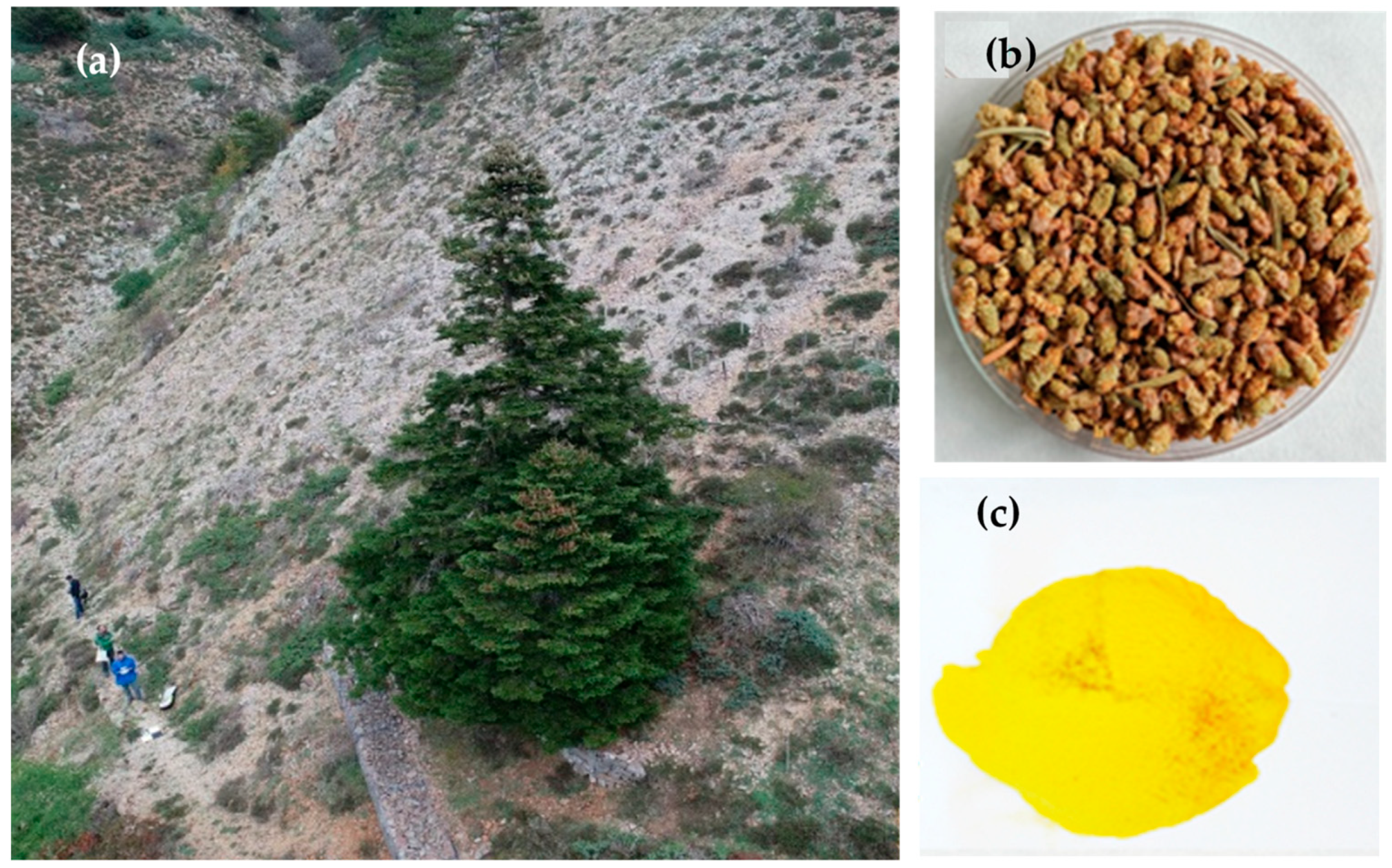
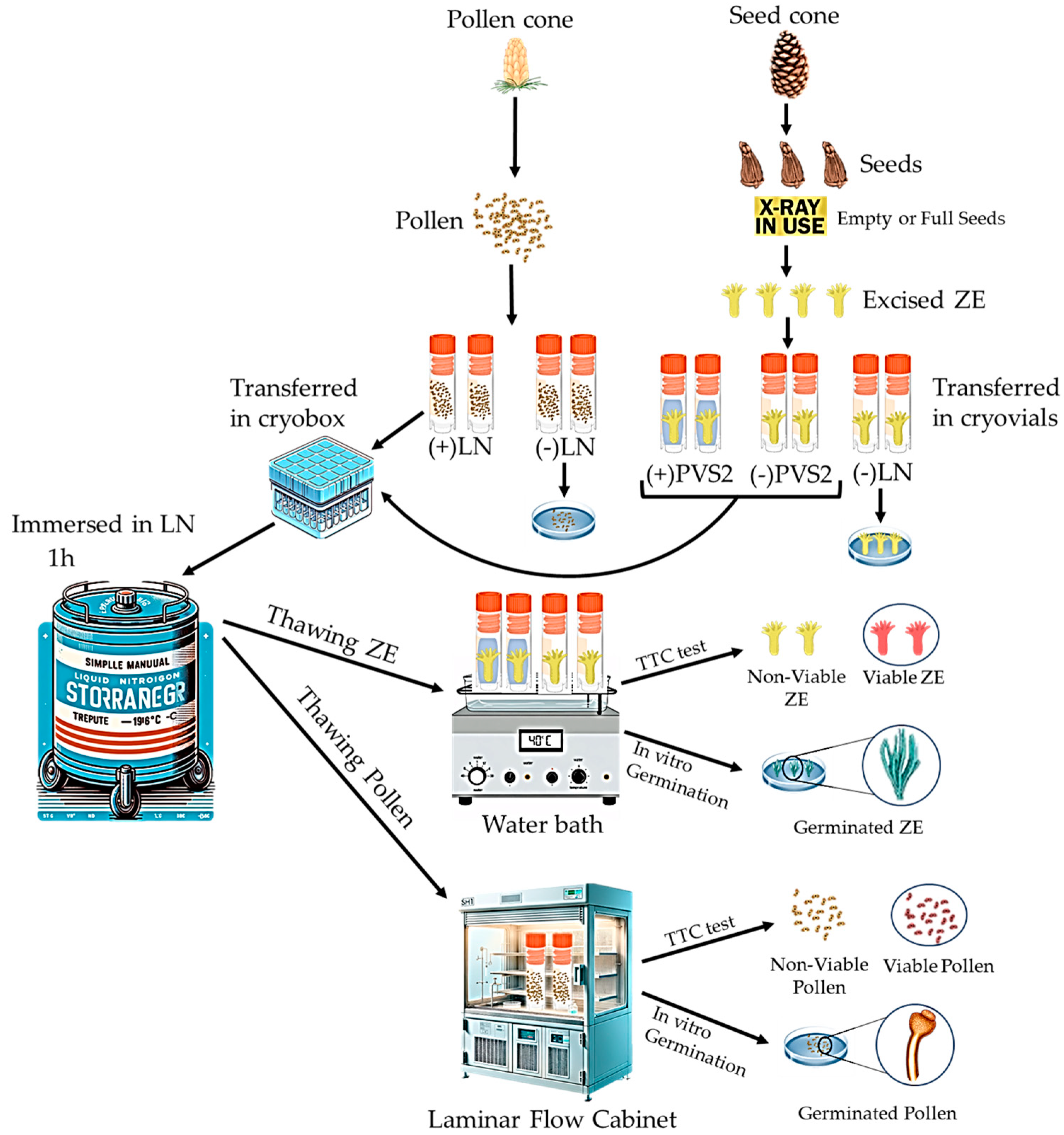
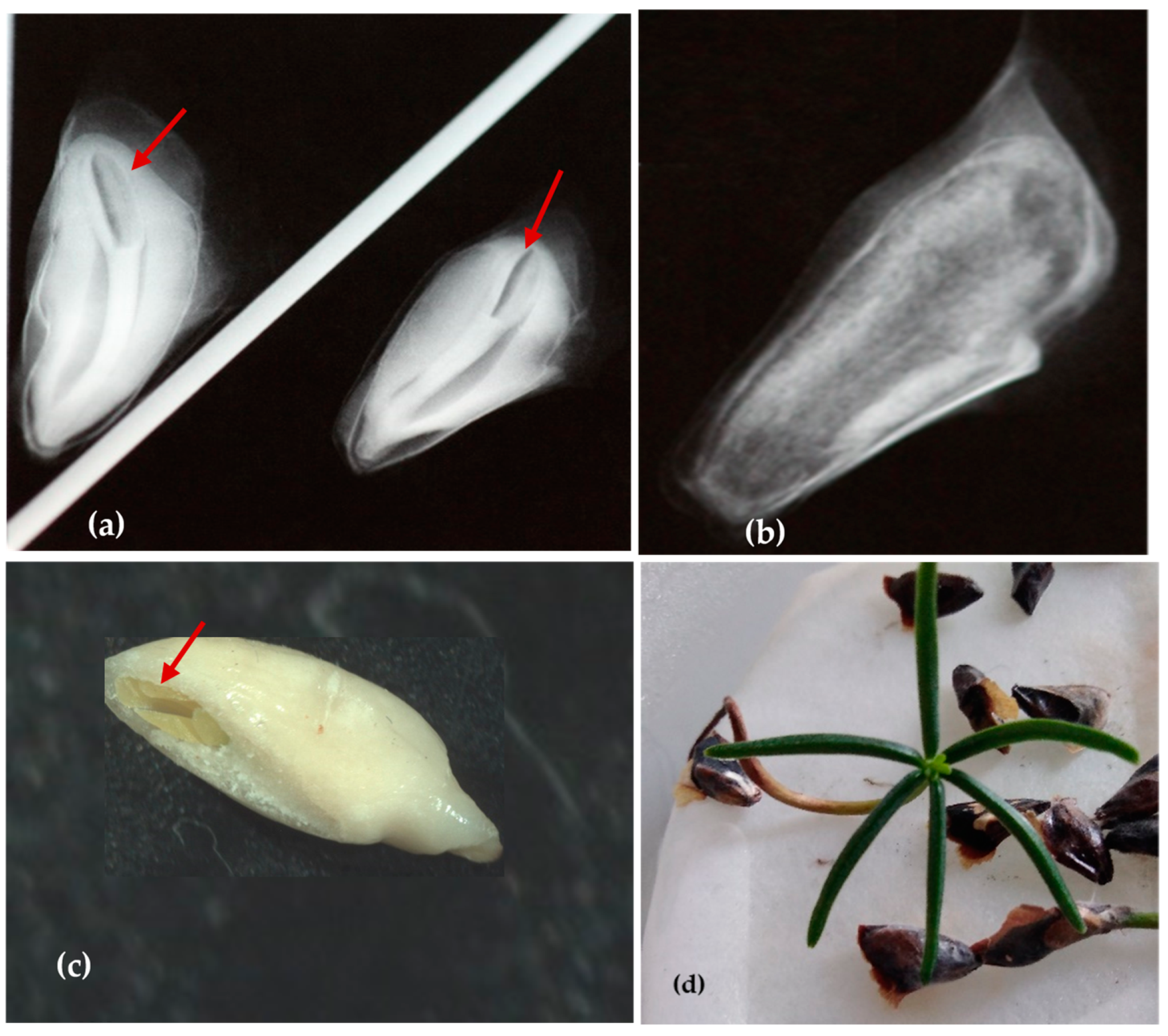
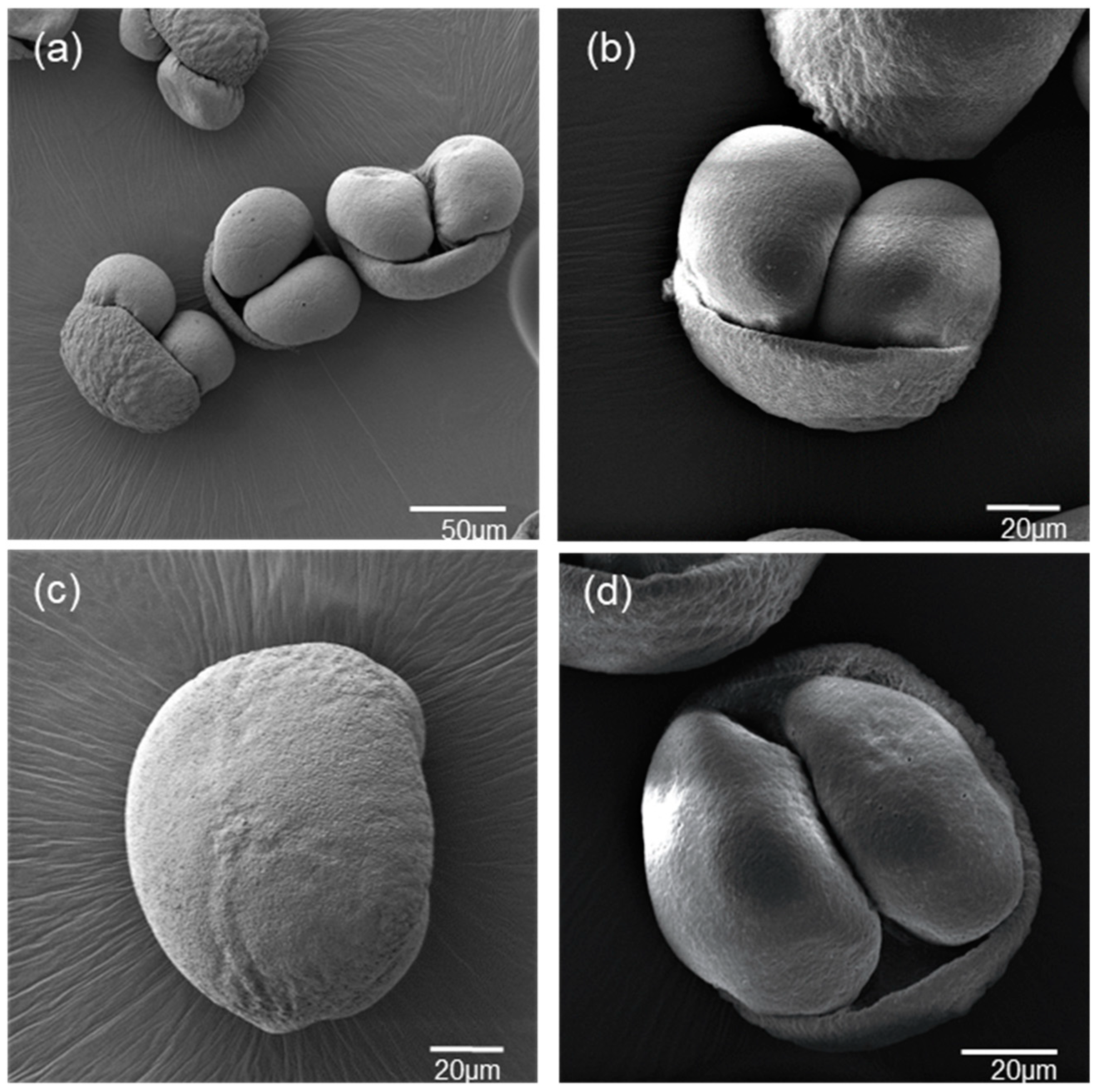
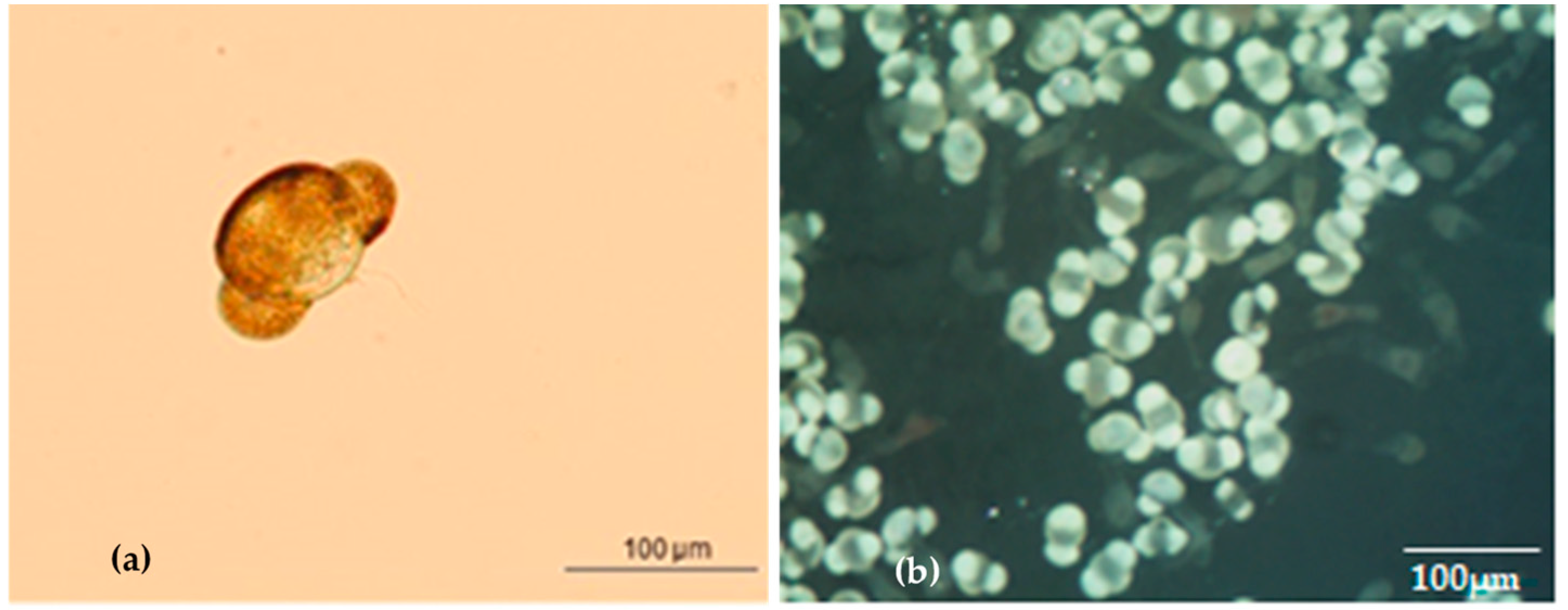
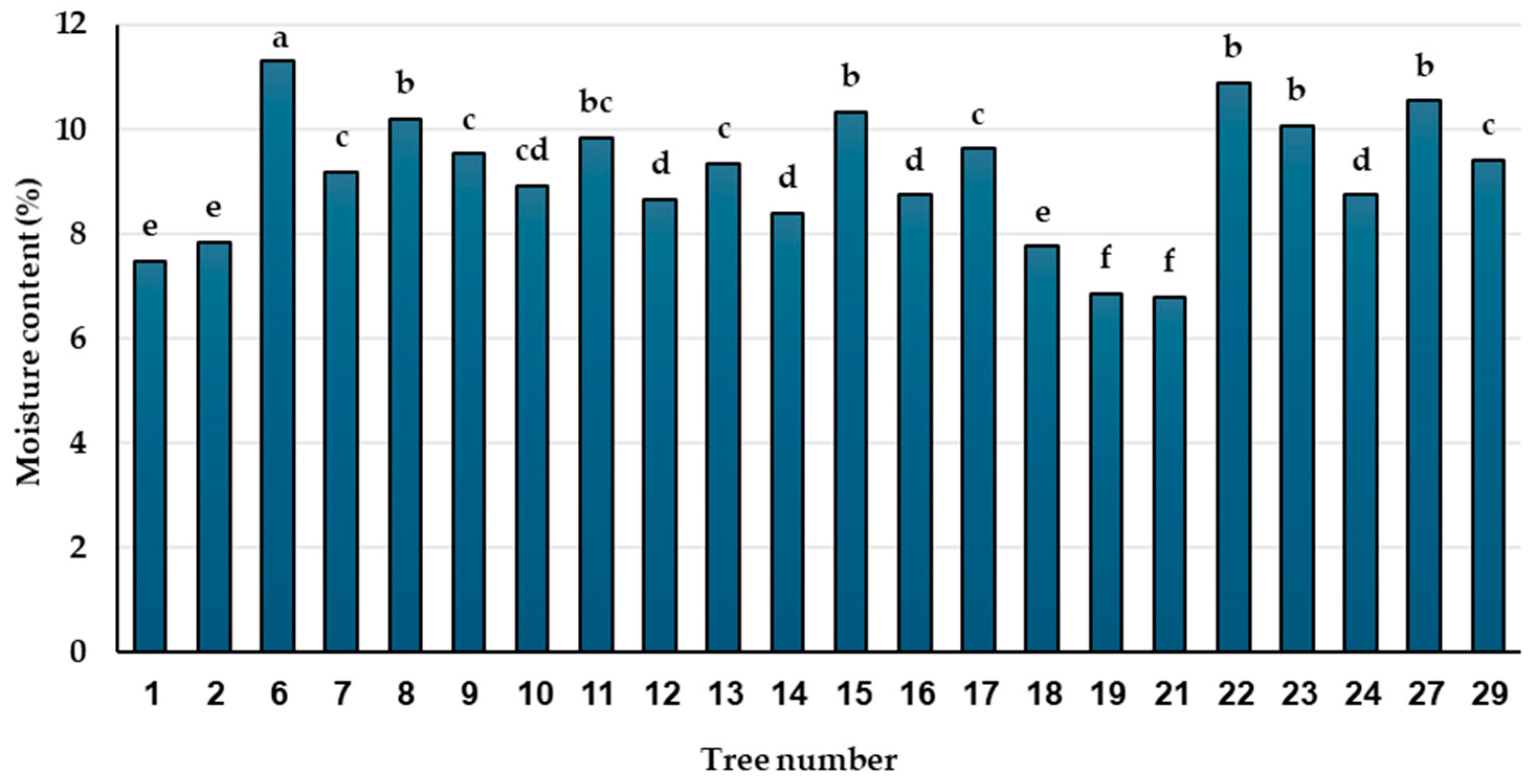
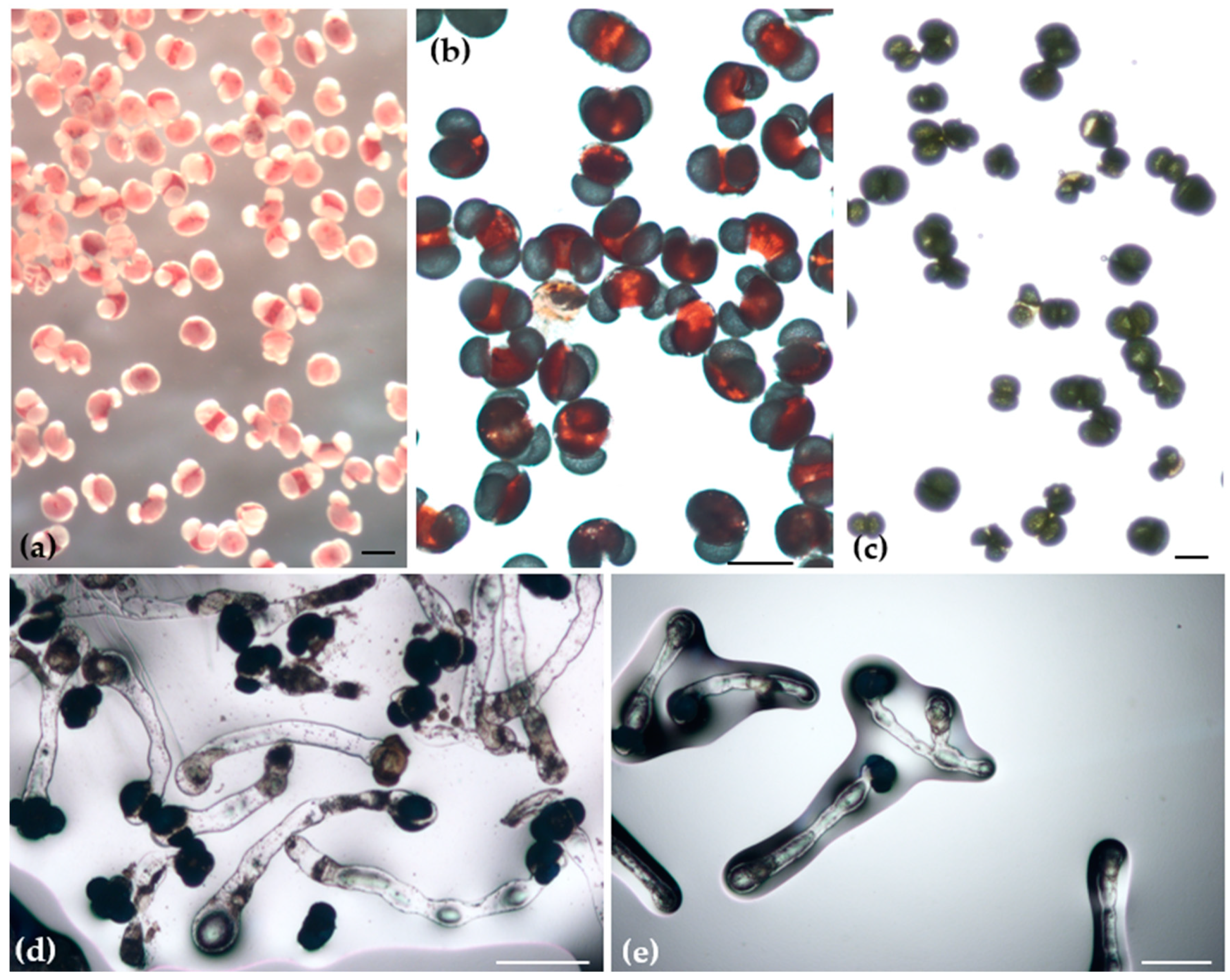


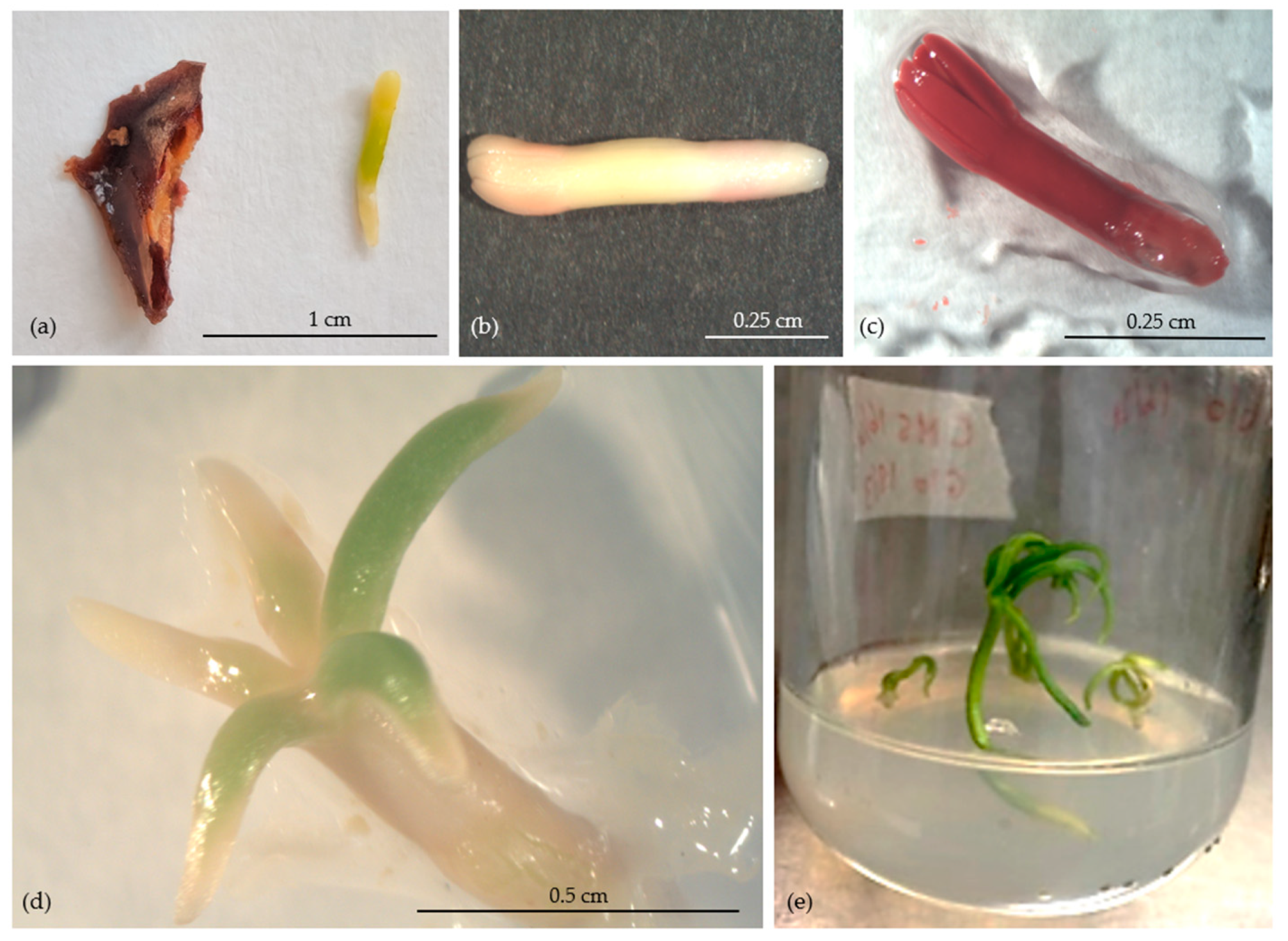

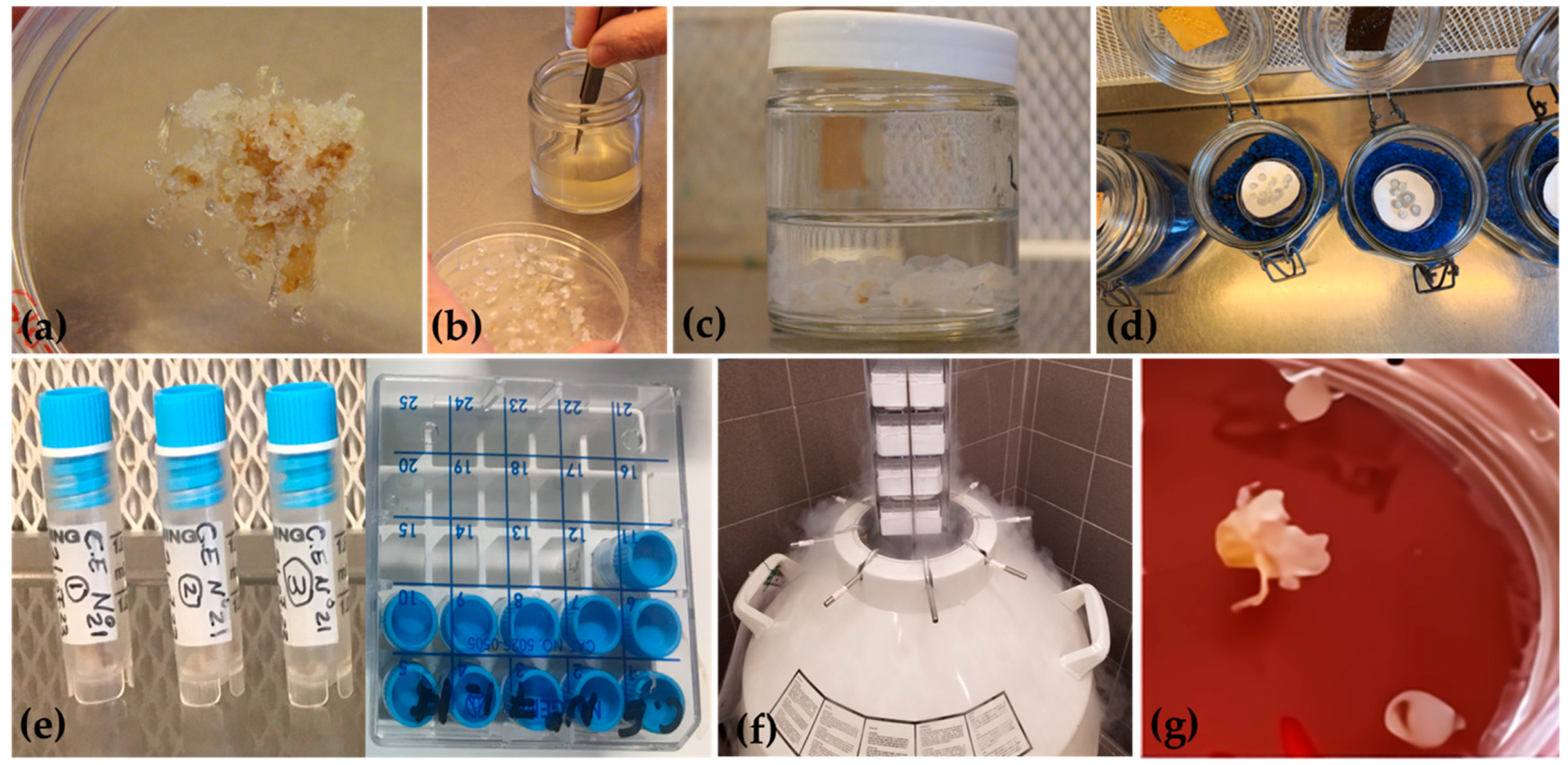
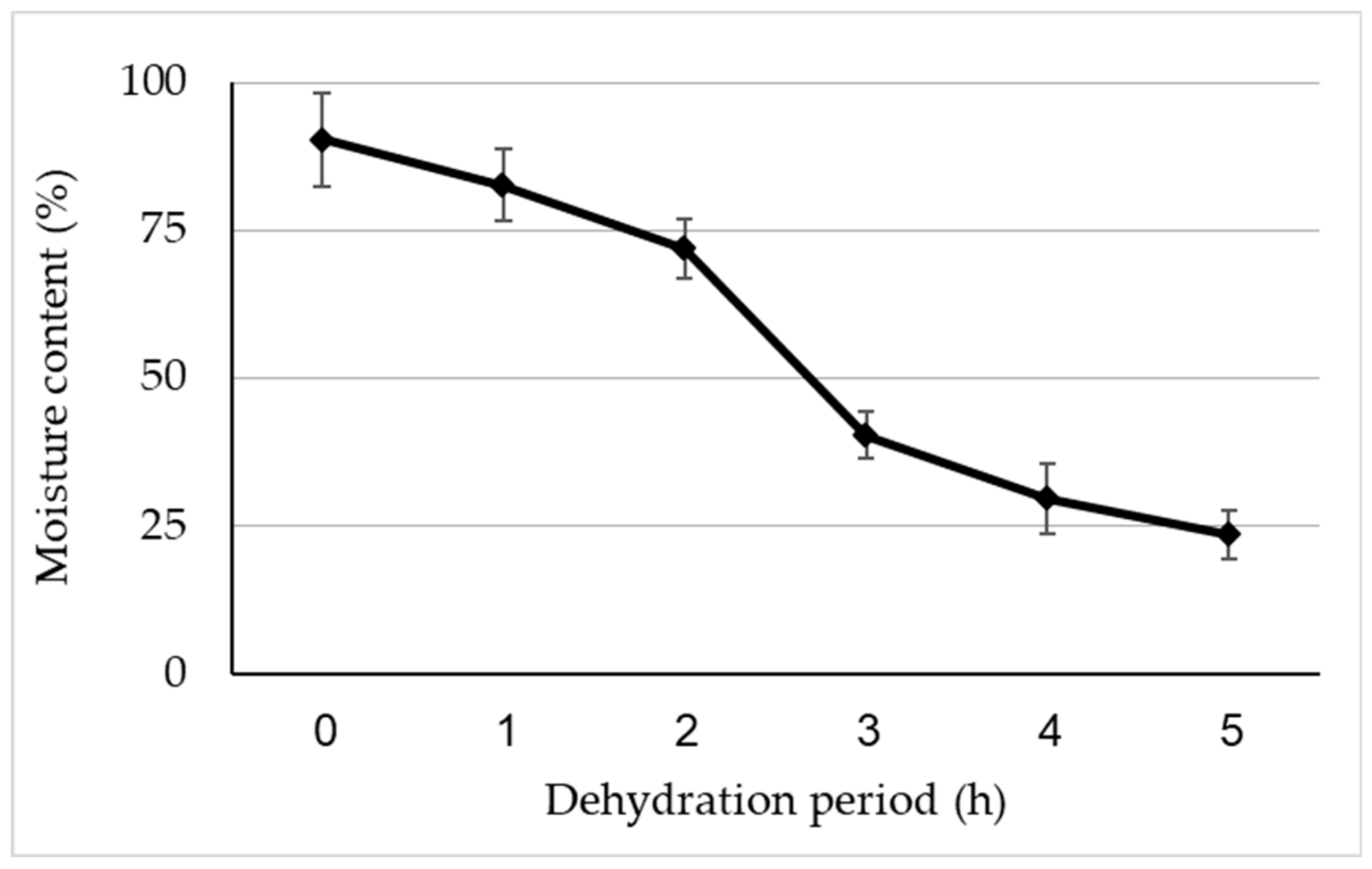
| N° Tree (T) | Treatment (Tr) | Tr xT | T Mean | Tr Mean |
|---|---|---|---|---|
| 1 | Control | 77.77 h–l | 76.14 GHI | |
| +LN | 74.51 i–m | |||
| 2 | Control | 9.16 n | 7.81 LM | |
| +LN | 6.45 n | |||
| 6 | Control | 90.00 b–f | 92.54 ABC | |
| +LN | 95.08 abc | |||
| 7 | Control | 88.89 c–g | 79.51 FGH | |
| +LN | 70.14 klm | |||
| 8 | Control | 98.88 a | 95.29 A | |
| +LN | 91.69 b–f | |||
| 9 | Control | 79.16 g–k | 85.94 DEF | |
| +LN | 92.71 bcde | |||
| 10 | Control | 88.16 b–f | 90.94 ABCD | |
| +LN | 93.72 bcd | |||
| 11 | Control | 90.55 b–f | 92.10 ABCD | |
| +LN | 93.66 bcd | Control | ||
| 12 | Control | 65.88 lm | 74.08 GHI | 68.93 B |
| +LN | 82.27 f–j | |||
| 13 | Control | 90.44 bcde | 89.89 BCD | |
| +LN | 89.33 b–g | +LN | ||
| 14 | Control | 74.99 i–m | 74.07 HI | 73.22 A |
| +LN | 73.14 i–m | |||
| 15 | Control | 65.83 lm | 68.27 IJ | |
| +LN | 70.70 klm | |||
| 16 | Control | 90.27 b–f | 87.14 DEF | |
| +LN | 84.02 e–i | |||
| 17 | Control | 93.61 bcd | 93.80 AB | |
| +LN | 93.99 bcd | |||
| 18 | Control | 96.39 ab | 95.95 AB | |
| +LN | 95.52 abc | |||
| 19 | Control | 3.88 n | 5.79 M | |
| +LN | 7.69 n | |||
| 21 | Control | 4.99 n | 34.68 K | |
| +LN | 33.29 m | |||
| 22 | Control | 33.05 m | 59.85 J | |
| +LN | 86.65 d–h | |||
| 23 | Control | 98.88 a | 82.63 CDE | |
| +LN | 66.38 lm | |||
| 24 | Control | 94.44 bcd | 93.86 AB | |
| +LN | 93.28 bcd | |||
| 27 | Control | 71.94 jklm | 82.09 EFG | |
| +LN | 92.24 b–f | |||
| 29 | Control | 9.26 n | 16.85 L | |
| +LN | 24.43 m | |||
| p value | 0.0002 *** | 0.0001 *** | 0.0001 *** | |
| N° Tree (T) | Treatment (Tr) | TrxT | T Mean | Tr Mean |
|---|---|---|---|---|
| 1 | Control | 84.72 l–p | 83.69 G | |
| +LN | 82.66 op | |||
| 2 | Control | 22.62 qr | 20.83 I | |
| +LN | 41.66 q | |||
| 6 | Control | 88.89 i–p | 87.77 EFG | |
| +LN | 86.66 k–p | |||
| 7 | Control | 90.00 h–p | 85.00 FG | |
| +LN | 80.00 p | |||
| 8 | Control | 91.11 h–p | 91.55 DEF | |
| +LN | 92.00 g–o | |||
| 9 | Control | 87.77 j–p | 88.38 EFG | |
| +LN | 89.00 i–p | |||
| 10 | Control | 98.61 abcd | 95.80 ABC | |
| +LN | 93.00 f–o | |||
| 11 | Control | 93.89 d–l | 92.44 CDE | |
| +LN | 91.00 h–p | |||
| 12 | Control | 92.22 g–o | 91.44 CDE | Control |
| +LN | 90.66 e–m | 79.16 B | ||
| 13 | Control | 89.44 i–p | 92.88 CDE | |
| +LN | 96.33 a–h | +LN | ||
| 14 | Control | 99.44 ab | 95.38 ABC | 81.95 A |
| +LN | 91.33 e–n | |||
| 15 | Control | 99.72 a | 96.69 AB | |
| +LN | 93.66 b–j | |||
| 16 | Control | 90.83 h–p | 94.25 BCD | |
| +LN | 97.66 a–g | |||
| 17 | Control | 85.83 l–p | 92.08 CDE | |
| +LN | 98.33 a–e | |||
| 18 | Control | 83.61 n–p | 84.14 FG | |
| +LN | 84.66 m–p | |||
| 19 | Control | 23.89 qr | 11.94 I | |
| +LN | 0.00 t | |||
| 21 | Control | 30.28 q | 62.14 H | |
| +LN | 94.00 c–k | |||
| 22 | Control | 91.66 g–o | 92.50 CDE | |
| +LN | 93.33 e–m | |||
| 23 | Control | 98.05 a–f | 98.69 A | |
| +LN | 99.33 a | |||
| 24 | Control | 98.89 abcd | 98.94 A | |
| +LN | 99.00 abc | |||
| 27 | Control | 90.83 h–p | 93.41 CDE | |
| +LN | 96.00 a–i | |||
| 29 | Control | 9.16 s | 10.91 I | |
| +LN | 12.66 rs | |||
| p value | 0.0001 *** | 0.0009 *** | 0.0001 *** | |
| N° Tree (T) | Treatment (Tr) | TrxT | T Mean | Tr Mean | |
|---|---|---|---|---|---|
| 6 | Control | UN | 33.33 a | ||
| +LN | −PVS2 | 100 a | 74.07 BC | ||
| +PVS2 | 88.88 a | ||||
| 8 | Control | UN | 83.33 a | ||
| +LN | −PVS2 | 88.88 a | 90.74 ABC | ||
| +PVS2 | 100 a | ||||
| 10 | Control | UN | 100 a | Control | |
| +LN | −PVS2 | 100 a | 100 A | 75.69 A | |
| +PVS2 | 100 a | ||||
| 12 | Control | UN | 66.66 a | ||
| +LN | −PVS2 | 66.66 a | 66.66 C | ||
| +PVS2 | 66.66 a | −PVS2 +LN | |||
| 13 | Control | UN | 88.89 a | 81.94 A | |
| +LN | −PVS2 | 66.66 a | 85.18 ABC | ||
| +PVS2 | 100 a | ||||
| 21 | Control | UN | 100 a | ||
| +LN | −PVS2 | 77.77 a | 88.88 ABC | +PVS2 +LN | |
| +PVS2 | 88.88 a | 92.01 A | |||
| 22 | Control | UN | 33.33 a | ||
| +LN | −PVS2 | 72.22 a | 65.74 C | ||
| +PVS2 | 91.66 a | ||||
| 27 | Control | UN | 100 a | ||
| +LN | −PVS2 | 83.33 a | 94.44 AB | ||
| +PVS2 | 100 a | ||||
| p value | 0.2503 | 0.0498 * | 0.1126 | ||
| N° Tree (T) | Treatment (Tr) | TrxT | T Mean | T Tr Mean | |
|---|---|---|---|---|---|
| 6 | Control | UN | 88.89 ab | ||
| +LN | −PVS2 | 16.66 fghi | 35.18 B | ||
| +PVS2 | 0.00 i | ||||
| 8 | Control | UN | 83.33 abc | ||
| +LN | −PVS2 | 58.33 cde | 50.00 B | ||
| +PVS2 | 8.33 ghi | ||||
| 10 | Control | UN | 100 a | ||
| +LN | −PVS2 | 100 a | 100 A | Control | |
| +PVS2 | 100 a | 65.97 A | |||
| 12 | Control | UN | 33.33 efgh | ||
| +LN | −PVS2 | 33.33 efgh | 14.81 C | ||
| +PVS2 | 0.00 i | −PVS2 +LN | |||
| 13 | Control | UN | 77.78 abc | 39.79 B | |
| +LN | −PVS2 | 58.33 cde | 50.37 B | ||
| +PVS2 | 15 fghi | ||||
| 21 | Control | UN | 75 bcd | ||
| +LN | −PVS2 | 35 defg | 46.66 B | +PVS2 +LN | |
| +PVS2 | 30 d-f | 25.11 B | |||
| 22 | Control | UN | 36.11 defg | ||
| +LN | −PVS2 | 5.55 hi | 29.76 BC | ||
| +PVS2 | 47.61 cdef | ||||
| 27 | Control | UN | 33.33 efgh | ||
| +LN | −PVS2 | 11.11 ghi | 14.81 C | ||
| +PVS2 | 0.00 i | ||||
| p value | 0.0003 *** | 0.0001 *** | 0.0001 *** | ||
Disclaimer/Publisher’s Note: The statements, opinions and data contained in all publications are solely those of the individual author(s) and contributor(s) and not of MDPI and/or the editor(s). MDPI and/or the editor(s) disclaim responsibility for any injury to people or property resulting from any ideas, methods, instructions or products referred to in the content. |
© 2024 by the authors. Licensee MDPI, Basel, Switzerland. This article is an open access article distributed under the terms and conditions of the Creative Commons Attribution (CC BY) license (https://creativecommons.org/licenses/by/4.0/).
Share and Cite
Benelli, C.; Tarraf, W.; İzgü, T.; Anichini, M.; Faraloni, C.; Salvatici, M.C.; Jouini, N.; Germanà, M.A.; Danti, R.; Lambardi, M. Long-Term Conservation for the Safeguard of Abies nebrodensis: An Endemic and Endangered Species of Sicily. Plants 2024, 13, 1682. https://doi.org/10.3390/plants13121682
Benelli C, Tarraf W, İzgü T, Anichini M, Faraloni C, Salvatici MC, Jouini N, Germanà MA, Danti R, Lambardi M. Long-Term Conservation for the Safeguard of Abies nebrodensis: An Endemic and Endangered Species of Sicily. Plants. 2024; 13(12):1682. https://doi.org/10.3390/plants13121682
Chicago/Turabian StyleBenelli, Carla, Waed Tarraf, Tolga İzgü, Monica Anichini, Cecilia Faraloni, Maria Cristina Salvatici, Nourhene Jouini, Maria Antonietta Germanà, Roberto Danti, and Maurizio Lambardi. 2024. "Long-Term Conservation for the Safeguard of Abies nebrodensis: An Endemic and Endangered Species of Sicily" Plants 13, no. 12: 1682. https://doi.org/10.3390/plants13121682
APA StyleBenelli, C., Tarraf, W., İzgü, T., Anichini, M., Faraloni, C., Salvatici, M. C., Jouini, N., Germanà, M. A., Danti, R., & Lambardi, M. (2024). Long-Term Conservation for the Safeguard of Abies nebrodensis: An Endemic and Endangered Species of Sicily. Plants, 13(12), 1682. https://doi.org/10.3390/plants13121682










